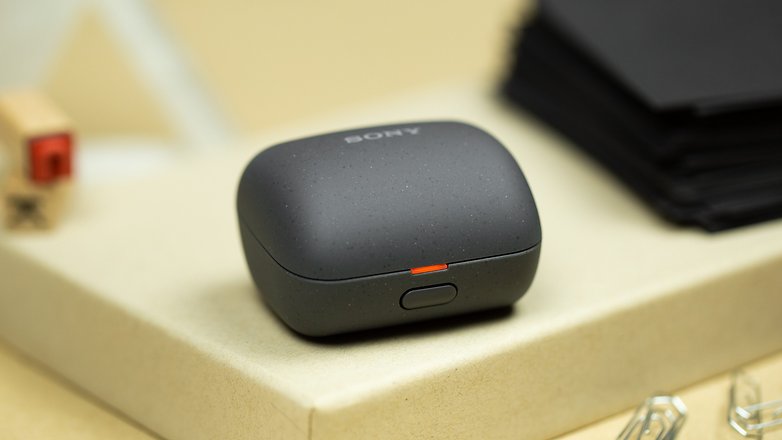Sony LinkBuds review: The most exciting headphones today


Why do Sony's LinkBuds resemble recycled fidget spinners? Well, that is because they're the first open in-ear headphones in the market. This means you can hear ambient noise while listening to your favorite music and podcasts without having to activate transparency modes electronically. Read our review to find out how good they are in everyday use!
Good
- Innovative driver design
- Barely noticeable when worn
- Very compact charging case
- Unique operation method
Bad
- Less flexible than ANC earbuds equipped with transparency mode
- Limited performance for its bass range
- Battery life is rather mediocre
- High audio bleeding

Sony LinkBuds in a nutshell
My headline unabashedly called the LinkBuds out as the most exciting headphones on the market right now. This is because Sony dared to venture into something really new with the WF-809. Sony's idea of launching earbuds that allow ambient noise to pass through works really well. It's an entirely new listening experience, but at the same time, really impractical in many situations. Even though they may sound a little worse than usual and is more artificial in transparency mode, ANC headphones with transparency modes are still far more flexible.
Although the sound quality can be hard to compare with alternatives, the LinkBuds do sound solid. However, you cannot hope for a hi-fi level of quality or concentrated music listening when you are outside the home. Just about all of its bass will disappear, but the sound of the other frequencies is surprisingly clear and loud enough even when you are surrounded by traffic.

Apart from the very specific purpose, there are complaints about the grip that is less than optimal in addition to the rather short battery life of 5.5 hours. Do take note of the tiny, chubby charging case. True to the motto "better have than not", I would personally prefer a pair of ANC headphones with a good transparency mode when I am in traffic. As a buying guide, I would have to award it a score of 3.5 stars - not because of a lack of quality, but because of rather limited usage scenarios.
Sony LinkBuds design and build quality
Design-wise, the headphones take a lot of getting used to, and that also affects the wearing comfort. The LinkBuds sit differently than all other in-ear headphones because they basically cling to the inner walls of your ears. In return, it is ultra-lightweight and overall, the Sony WF-809 is surprisingly compact.
What I liked:
- Barely noticeable when worn.
- Ultra-light.
- Usable without having to read the instructions despite sporting a new design.
What I disliked:
- Does not stay secure during movements.
- Adjustments constantly lead to activating the touch controls.
- Tiny charging case constantly fell off during the review.
I don't think I have to explain that the LinkBuds are a completely unique pair of in-ear headphones upon its release. The use of open drivers forced Sony to rethink its design, and so the LinkBuds consist of two circles. They are held in place by a small fin, which comes in different sizes, and the driver, which rests on the small plane in front of your auditory canal.

The wearing comfort of the LinkBuds is very high, and thanks to the light weight, you will hardly feel the buds when worn. While the hold is great while walking and sitting, the LinkBuds sat too loosely for my taste during sporting activities. I had to frequently re-lock them to prevent them from falling out while running.
The LinkBuds' charging case is remarkable, as it is really tiny with dimensions of 41.4 x 48.5 x 30.9 millimeters. Unlike most competitors, it is opened via a small button and not magnetically. Opening it is simple and inserting the earbuds is also very easy.

However, the size of the case meant that I constantly dropped the case during the review duration. This might be the reason why Sony decided against a magnetic closing mechanism - they usually pop open when the earbuds' case falls to the ground. Despite the extra layer of security, I found the charging cradle a bit too fiddly to use.
Operation and comfort features
Sony's innovation department has also done a good job with the controls. In addition to touch-sensitive surfaces on the earbuds themselves, you can also simply tap on your temples or cheeks. Sony's standard application for headphones is used as an app, and there is also wear detection and adaptive volume control.
What I liked:
- Clever controls that lets you tap your face.
- Adaptive volume control.
- Wear detection is always cool.
What I disliked:
- Advanced touch controls can be rather error-prone.
There are a few things that I'd like to point out about the LinkBuds in terms of controls and convenience features. As if the novel design wasn't exciting enough, the LinkBuds also offer a new type of control. Instead of simply tapping the earbuds to skip a song, for instance, you can also tap your temple or cheek after activating the "wide range tap" feature.

This looks relatively silly in the review but works surprisingly well. Unfortunately, Sony does not let you adjust the sensitivity of this feature, which can be annoying in some situations. Thus, it often happened in the review that the headphones switched from one song to another when walking or jogging. It can be a bit annoying, especially if you like to listen to podcasts while jogging and lose the track's position halfway.
Rather automatically, the Sony LinkBuds can also adjust the volume as you move around. The "adaptive volume" feature adjusts the volume based on the surrounding noise and ensures that you can always hear your surroundings. The automatic feature works very reliably, as my review with over-the-ear headphones over the earbuds with increasing noise showed.

Sound quality
The sound quality of the Sony LinkBuds is unparalleled due to the open driver design. This is because the drivers have been provided with a hole to let more ambient noise reach the ear. From a purely technical point of view, the earbuds cover a frequency range of 20 hertz to 20 kilohertz and offer support for DSEE as well as Sony's 360-degree audio.
What I liked:
- Solid sound in quiet environments.
- Sounds nice, clear, and defined.
- App customization options.
What I disliked:
- Strong audio bleeding.
- Bass gets lost.
- Health concerns (just my personal opinion).
The sound of the Sony LinkBuds is pretty challenging to compare to traditional in-ear headphones. They reminded me a bit of products like the Bose Frames or the Fauna Audio Glasses. Audio products, in other words, that provide your ears with music in a rather passive manner while letting ambient noise through without any electronic aid.
Compared to audio glasses, which transmit sound to the ear canal via small, directional speakers, the sound is much clearer and more defined here. After all, the driver in the LinkBuds is still located in front of the ear canal. The earbuds, therefore, sound very decent in quiet environments, although the music clearly lacks bass. Even with Bass Boost enabled, the LinkBuds cannot really build up pressure in the low-frequency range.

This is not too bad at all, because the LinkBuds are really ingenious when it comes to road traffic. You will feel like you're walking around in your own movie with a fitting soundtrack, as the music comes from nowhere to your ear. In noisy environments, however, you tend to increase the volume of the headphones to still be able to listen to your podcasts or music. I would be more cautious here in the long run, since the tendency to turn up the volume can be harmful to your ears over time. This is especially true since the headphones don't filter ambient noise, which adds to the strain.
Battery life: Rather short with the mini charging case
Sony claims a runtime of 5.5 hours for the LinkBuds during active music playback. You can get another 12 hours via the included charging case.
What I liked:
- Compact charging case adds 12 hours of runtime.
- Quick charging.
- Solid runtime for a compact size.
What I disliked:
- Battery life is rather mediocre compared to other models.
- No wireless charging supported.
After my practical review, I was able to confirm Sony's information about the battery life. Thus, the headphones lasted 5.5 hours when you wear them continuously and listen to music. The headphones do not support ANC, which does not have a big impact on the battery life. You can wring out another 12 hours via the included charging case.

A total runtime of 17.5 hours is decent. However, the runtime of 5.5 hours is rather mediocre compared to other in-ear Bluetooth earbuds. You won't be able to listen to music for a full workday when wearing them continuously. Considering the compact size of the earbuds though, I am satisfied with the battery life of the LinkBuds.
Once the LinkBuds are completely drained, they can be recharged within 10 minutes so that you can listen to music for another 90 minutes. This is perfect if you need some power for music before jogging, but wireless charging support is missing here. You will always have to use the USB-C port at the back to charge the headphones.
What do I think of it?
My personal conclusion of the Sony LinkBuds? It will sound a bit more negative than the reviews of my colleagues elsewhere. This is because while I find the LinkBuds to be technically ingenious, I would advise most people not to buy them. After all, even though the ambient noise sounds clearer and more natural through open drivers, I find the earbuds to lack some sort of plug that allows me to turn off the noise when needed.
After all, it's not always practical to be aware of your surroundings while wearing headphones. Whether it's on an airplane, where the background noise is already high, or on the train, or when someone is in a quiet compartment on the phone. Being able to block out the surroundings is one of the most practical developments of modern headphones and earbuds.
Personally, I've been using the OnePlus Buds Pro for a few months now with ANC and a transparency mode that's super easy to access and offers decent quality. This allows me to hear what's going on in my environment or just get lost in my music, depending on my preference. I do think that I have made my point clear by now: The LinkBuds are super cool, but just too rigid in everyday life to be really dangerous to the ANC competition.
But that is also somehow the fascination with Sony. Where else are there regular brands that really dare to venture something new and different? Where else will smartphones that cost $1,800 or more but can stream videos with 4K resolution via 5G, or where a 1-inch sensor with a variable aperture is used? Sony is fighting against the one-size-fits-all approach, which is why the LinkBuds are very important!



















